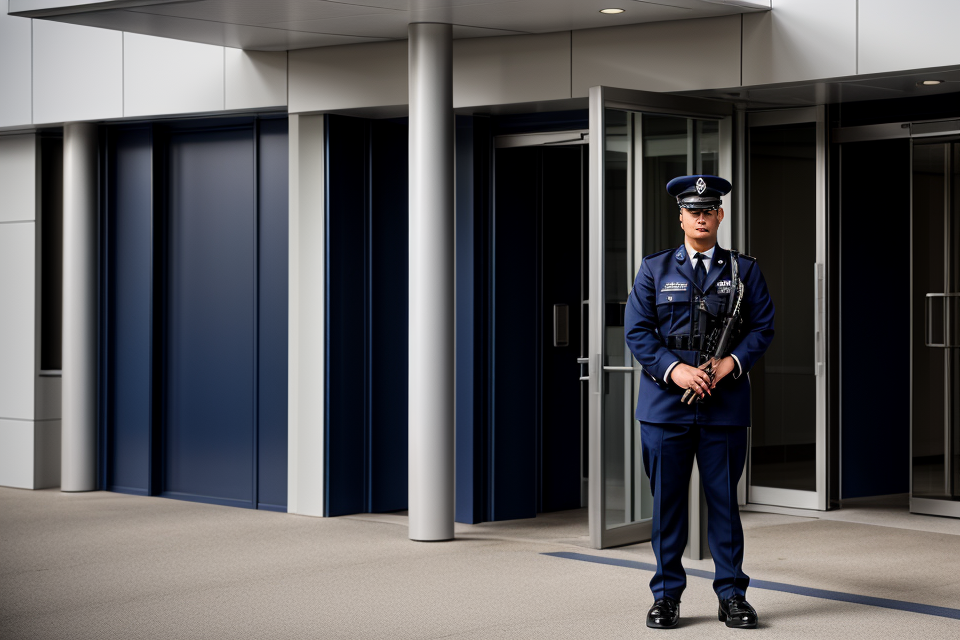
Uniforms are a common sight in many workplaces, schools, and organizations. While some may see them as a hindrance to individuality, there are several reasons why wearing uniforms is important. In this article, we will explore the significance of uniforms and how they contribute to safety and consistency. From promoting a sense of belonging to enhancing professionalism, uniforms play a vital role in creating a cohesive and efficient environment. So, let’s dive in and discover the reasons why uniforms matter.
The Role of Uniforms in Ensuring Safety
Promoting a Professional Image
The Importance of a Professional Appearance in Maintaining Safety Standards
Maintaining a professional appearance through the use of uniforms is essential in ensuring safety standards are upheld. This is because a well-presented individual is more likely to take their responsibilities seriously, and as a result, they are more likely to adhere to safety protocols. In many industries, such as construction, healthcare, and law enforcement, the wearing of uniforms is mandatory, as it helps to identify individuals who are authorized to be in certain areas, and it helps to differentiate between staff and visitors.
How Uniforms Contribute to a Positive Work Environment
In addition to promoting safety, uniforms also contribute to a positive work environment. When everyone is dressed in a consistent manner, it helps to create a sense of unity and teamwork. This is because uniforms help to establish a common identity among employees, which can foster a sense of belonging and pride in their work. Furthermore, when employees wear uniforms, it can help to eliminate any distractions that may arise from differences in personal style or attire, allowing everyone to focus on their work and their responsibilities.
The Impact of Uniforms on Customer Perception
Finally, it is worth noting that uniforms can also have an impact on customer perception. When employees wear uniforms, it helps to establish a professional image and convey a sense of competence and reliability. This can be particularly important in industries such as hospitality, where first impressions are crucial. By wearing a uniform, employees can help to create a positive image for their company, which can lead to increased customer satisfaction and loyalty.
Overall, the use of uniforms is an important aspect of ensuring safety and consistency in the workplace. By promoting a professional image, contributing to a positive work environment, and impacting customer perception, uniforms play a vital role in creating a successful and productive workplace.
Standardizing Safety Protocols
One of the key benefits of wearing uniforms is that they can help standardize safety protocols within an organization. Clear safety guidelines are essential for ensuring the well-being of employees, and uniforms can play a crucial role in communicating these guidelines. By wearing a uniform, employees are able to easily identify areas that require improvement in safety measures, and take appropriate action to address them.
For example, a construction company may require all employees to wear a hard hat as part of their uniform. This not only helps to protect against head injuries, but also serves as a visual reminder of the importance of safety on the job site. Similarly, a healthcare provider may require all employees to wear a lab coat, which serves as a symbol of professionalism and reinforces the importance of maintaining a clean and sterile environment.
Additionally, uniforms can help to promote a culture of safety within an organization. When everyone is wearing the same uniform, it helps to create a sense of unity and shared purpose. This can encourage employees to take safety seriously and work together to ensure that everyone goes home safe at the end of the day.
Overall, the standardization of safety protocols through the use of uniforms is an important aspect of ensuring a safe and healthy work environment. By providing clear visual cues and promoting a culture of safety, uniforms can help to reduce the risk of accidents and injuries, and contribute to a more positive workplace culture.
Enhancing Visibility and Security
Uniforms play a crucial role in enhancing visibility and security in various settings, including public spaces, transportation hubs, and industrial workplaces. Security personnel often rely on their uniforms to establish a visible presence and project authority, deterring potential criminal activity. Here are some ways in which uniforms contribute to enhancing visibility and security:
- Improved visibility: Uniforms, especially those with distinctive designs or colors, make security personnel more easily recognizable and visible to the public. This increased visibility can deter criminal activity and aid in the identification of suspicious individuals. For instance, police officers’ uniforms are designed to stand out, making it easier for the public to identify them and seek assistance in case of emergencies.
- Clear identification: Uniforms can also help in the clear identification of security personnel, allowing for easier communication and coordination during emergencies. For example, firefighters’ uniforms feature distinctive colors and insignia, enabling other emergency responders to quickly recognize them and collaborate during firefighting operations.
- Establishing authority: The wearing of uniforms by security personnel can also serve to establish their authority and convey a sense of control in various situations. This perception of authority can contribute to the prevention of criminal activity, as individuals may be less likely to engage in illegal behavior when they perceive a strong security presence.
- Psychological impact: The use of uniforms can also have a psychological impact on potential criminals, creating a sense of intimidation and apprehension. The sight of a uniformed security officer may deter individuals from engaging in criminal activity, as they may fear being caught or confronted by the officer.
In conclusion, uniforms play a critical role in enhancing visibility and security by improving the recognition and identification of security personnel, establishing their authority, and creating a psychological deterrent to criminal activity.
The Impact of Uniforms on Consistency and Accountability
Fostering a Sense of Community
One of the primary reasons why uniforms are important in the workplace is that they foster a sense of community among employees. A shared identity among employees can lead to a more cohesive and productive work environment. Uniforms can help promote a sense of belonging and teamwork, as they serve as a visual representation of the company culture and values.
Uniforms create a level of equality among employees, as everyone is required to wear the same attire. This equality helps to break down barriers and promote a sense of camaraderie among workers. When everyone is dressed in the same way, it creates a sense of unity and helps to eliminate the feeling of being part of a hierarchy. This is particularly important in environments where employees may come from diverse backgrounds and have different cultural experiences.
Moreover, uniforms can also help to reinforce the company’s culture and values. By wearing a uniform, employees are constantly reminded of the company’s mission and goals. This can help to align individual goals with those of the organization, creating a shared sense of purpose. Uniforms can also serve as a reminder of the company’s commitment to its customers and clients, which can further enhance the sense of community among employees.
Additionally, uniforms can help to promote a sense of accountability among employees. When everyone is dressed in the same way, it becomes easier to identify employees who are not following the dress code. This can help to maintain a level of professionalism and ensure that all employees are adhering to the company’s standards. Uniforms can also help to identify employees who are not authorized to be in certain areas of the workplace, further enhancing accountability.
In conclusion, uniforms play a significant role in fostering a sense of community among employees. They help to create a level of equality, reinforce the company’s culture and values, and promote accountability. By wearing a uniform, employees are reminded of their shared identity and the company’s commitment to its customers and clients. This can lead to a more cohesive and productive work environment, ultimately benefiting the organization as a whole.
Encouraging Accountability
Uniforms play a crucial role in promoting accountability among individuals, particularly in professional settings. By wearing a uniform, individuals are able to clearly identify their role and responsibilities within an organization, which can help foster a sense of personal responsibility and accountability. Additionally, uniforms can help identify and address issues with accountability by providing a clear visual representation of an individual’s role and responsibilities.
One of the primary ways that uniforms encourage accountability is by establishing a clear visual representation of an individual’s role and responsibilities within an organization. This can help individuals understand their role within the organization and the specific tasks and responsibilities that are expected of them. For example, a nurse wearing a nurse’s uniform is easily identifiable as a healthcare professional and is expected to adhere to specific standards of conduct and performance. Similarly, a police officer wearing a police uniform is easily identifiable as a law enforcement officer and is expected to adhere to specific laws and regulations.
Moreover, uniforms can also help identify and address issues with accountability by providing a clear visual representation of an individual’s role and responsibilities. This can help identify individuals who may be failing to meet expectations or who may be engaging in unacceptable behavior. For example, if a student is consistently late to class or is disruptive in class, a teacher may be able to identify the student as someone who is not meeting expectations by their lack of uniform compliance. Similarly, if an employee is consistently late or absent from work, a supervisor may be able to identify the employee as someone who is not meeting expectations by their lack of uniform compliance.
Overall, uniforms play a critical role in promoting accountability by establishing a clear visual representation of an individual’s role and responsibilities within an organization. By wearing a uniform, individuals are able to understand their role within the organization and the specific tasks and responsibilities that are expected of them. Additionally, uniforms can help identify and address issues with accountability by providing a clear visual representation of an individual’s role and responsibilities.
Maintaining Brand Identity
Uniforms play a crucial role in representing a company’s image and help establish and maintain brand identity. Here are some key points to consider:
- Consistent visual representation: Uniforms provide a consistent visual representation of a company, which helps to create a recognizable brand image. This is particularly important for businesses that rely on customer recognition, such as retail stores, restaurants, and hotels.
- Professional appearance: Uniforms also contribute to a professional appearance, which can enhance customer trust and confidence. For example, a well-designed uniform can convey a sense of professionalism, competence, and reliability, which can positively impact customer perceptions.
- Establishing brand values: Uniforms can also help to communicate a company’s values and culture. For instance, a uniform that reflects a brand’s commitment to sustainability or social responsibility can enhance its reputation and appeal to customers who share those values.
- Building brand recognition: Uniforms can also help to build brand recognition, particularly in crowded or competitive markets. By creating a distinctive look, businesses can differentiate themselves from competitors and make a lasting impression on customers.
Overall, the use of uniforms can have a significant impact on a company’s brand identity, helping to create a consistent and recognizable image that reflects its values and culture.
Balancing Individuality and Uniformity
Striking the Right Balance
The Importance of Allowing for Personal Expression within a Uniform Policy
One of the key factors in striking the right balance between individuality and uniformity is allowing for personal expression within a uniform policy. This can be achieved by providing employees with a range of options to choose from, such as different colors or styles of uniforms, or by allowing them to personalize their uniforms within certain guidelines. This can help employees feel more invested in their appearance and increase their sense of pride in their work.
How to Create a Balance between Individuality and Uniformity in the Workplace
Creating a balance between individuality and uniformity in the workplace requires careful consideration of the company’s values and goals, as well as the needs and preferences of employees. Here are some strategies that can help:
- Conduct a survey to gather feedback from employees about their preferences for uniform styles and colors. This can help you understand what options would be most appealing to your workforce and make it more likely that employees will feel comfortable and confident in their uniforms.
- Provide guidelines for personalizing uniforms, such as allowing employees to wear a specific pin or badge that represents their department or role. This can help employees feel more invested in their appearance and increase their sense of pride in their work.
- Consider offering a range of uniform options, such as different colors or styles, to allow employees to express their individuality within the context of the company’s overall uniform policy. This can help employees feel more comfortable and confident in their appearance while still maintaining a consistent image for the company.
- Communicate clearly with employees about the importance of adhering to the uniform policy, while also emphasizing the value of individuality and self-expression. This can help employees feel more invested in their appearance and increase their sense of pride in their work.
By following these strategies, companies can strike the right balance between individuality and uniformity, creating a consistent and professional image while also allowing employees to express their unique personalities.
Navigating the Challenges of a Diverse Workforce
When it comes to creating a uniform policy for a diverse workforce, there are several challenges that must be navigated.
Firstly, it is important to recognize that different cultures and beliefs may have varying opinions on what is considered appropriate attire. For example, some religions may require certain clothing items to be worn as a symbol of faith, while others may view certain garments as inappropriate or even offensive.
In addition, it is important to consider the various professions and roles within the workplace, as some may require specific clothing or protective gear to perform their job duties safely. For instance, a chef in a restaurant may need to wear a specific uniform to maintain a clean and sanitary kitchen, while a construction worker may require protective gear such as a hard hat and safety boots.
To accommodate these differences, it is important to involve employees from diverse backgrounds in the development of the uniform policy. This can include holding focus groups or surveys to gather input and feedback on what is considered appropriate and respectful attire for the workplace.
Furthermore, it is important to establish clear guidelines and expectations for the uniform policy, including any exceptions or accommodations that may be necessary for certain employees. This can help to ensure that all employees feel comfortable and respected in the workplace, while also maintaining a safe and consistent environment.
By navigating these challenges and creating a uniform policy that is inclusive and accommodating to all employees, a business can foster a positive and harmonious work environment that values diversity and promotes a sense of belonging for all employees.
FAQs
1. Why is it important to wear uniforms?
Uniforms are important for several reasons. Firstly, they help to establish a sense of unity and belonging among team members, as everyone is dressed in the same way. This can promote a sense of camaraderie and pride in being part of the team. Additionally, uniforms help to create a professional image and can contribute to a positive reputation for the team or organization.
2. Are uniforms only for work or school?
No, uniforms are not only for work or school. They can be worn in a variety of settings, including sports teams, military organizations, and even some social clubs. The purpose of wearing a uniform is to identify oneself as part of a particular group or organization and to promote a sense of unity and cohesion among members.
3. Are there any benefits to wearing uniforms besides looking professional?
Yes, there are several benefits to wearing uniforms. For example, uniforms can help to establish a level of safety and consistency within an organization. By wearing a uniform, employees or team members can easily identify one another and can quickly respond to any issues that may arise. Additionally, uniforms can help to reduce the risk of accidents or injuries, as they often include protective gear or clothing that is designed to meet specific safety standards.
4. Can I wear my own clothes to work or school instead of a uniform?
In most cases, it is not permitted to wear your own clothes to work or school instead of a uniform. This is because the uniform is designed to promote a sense of unity and cohesion among team members, and wearing your own clothes can disrupt this. Additionally, wearing your own clothes may not meet the necessary safety or dress code standards required by the organization. It is important to follow the rules and guidelines set by the organization when it comes to dress code and uniform policies.


